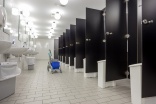Home › magazine › latest news › Airports switch to smart cleaning and hygiene concepts
Airports switch to smart cleaning and hygiene concepts
3rd of November 2025Beijing Daxing Airport has brought in a raft of smart washroom solutions in a bid to enhance cleaning efficiency and improve the passenger experience.
Infrared sensors, smart locks and other sensing devices are now being used to monitor the real-time occupancy of toilet cubicles. The collected data is then displayed on integrated screens, allowing travellers to check availability before entering the facility. Each cubicle is also equipped with red-green light indicators to clearly show which stalls are vacant.
Meanwhile, sensors embedded in dispensers for soap, toilet tissue and paper towels trigger an alert when supplies are running low, allowing cleaning staff to refill them when necessary. Any malodours are also quickly detected via the environmental monitoring system which has been installed to optimise air freshening and cleaning schedules.
And travellers are invited to provide feedback and suggestions electronically via an in-washroom evaluation system. The airport's property team then uses this data to refine and expand their services.
Airports in general are turning to technology to enhance the efficiency of their cleaning and hygiene services. For example, Boston Logan Airport now has a system whereby visitors "show" their empty drinks containers and other waste items to a bin which then determines in which receptacle it should be placed.
Cincinnati/Northern Kentucky Airport uses autonomous vehicles with robotic arms to handle passenger baggage and cargo more efficiently. And autonomous wheelchairs are now available at Baltimore/Washington International Thurgood Marshall Airport to make life easier for less abled passengers.








